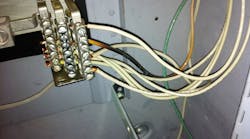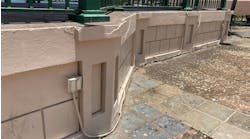How well do you know the Code? Think you can spot violations the original installer either ignored or couldn't identify? Here's your chance to moonlight as an electrical inspector and second-guess someone else's work from the safety of your living room or office. It's your turn to identify the violation.
Hint: A burning desire
Find the Answer
Whoa! That black wire is really supposed to be white. It’s black because it is overheating and starting to char. The problem was not due to an overloaded wire, but rather a poor connection at the terminal. Cranking a screw terminal too tight can compress the conductor too much and create a “hot spot” on the wire when it is carrying current. Leaving the terminal too loose can cause arcing and sparking, which can generate heat and damage the wire and terminal too.
These problems are why Sec. 110.14(D) was added to the 2017 Code. The new requirement states, “Where a tightening torque is indicated as a numeric value on equipment or in installation instructions provided by the manufacturer, a calibrated torque tool shall be used to achieve the indicated torque value, unless the equipment manufacturer has provided installation instructions for an alternative method of achieving the required torque.” While this may have already been a requirement per Sec. 110.3(B), which requires us to follow the instructions, this new rule acts as another reminder that terminal connections must be made up properly to ensure a safe installation. Enforcing this rule may be difficult for the AHJ, but nonetheless, installers must now follow this requirement.




